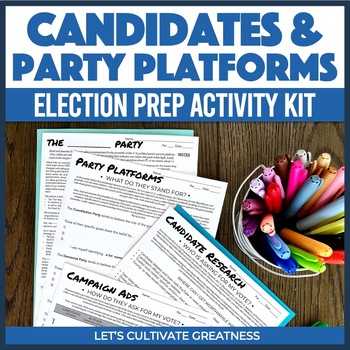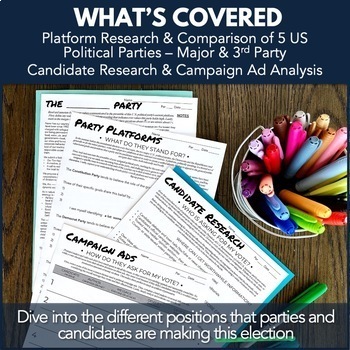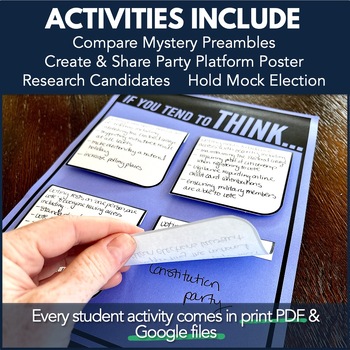Political Parties Platforms Mock Election Day Voting Activities
- PDF
- Google Apps™

What educators are saying
Description
Compare political party platforms, research candidates on the ballot, evaluate campaign ads, and conduct a mock Election Day in this activity kit.
There’s lots of flexibility to tailor to your upcoming local election, students’ interests, and time constraints.
Highly scaffolded with critical thinking and source skill-building, this universal kit is perfect for leading up to any election, year after year!
This kit comes in both print PDF and paperless Google files.
Get this and a bunch more activities in the complete 3-5 week Voting & Elections PBL Unit and make engaged citizens out of your students.
Greatness is being an engaged and informed constituent.
Nothing is more real or urgent than preparing your students to be informed voters, even when they aren't 18 and if it's an "off" year election.
Multiple studies have proven that when teenagers participate in voting, even a mock election, they are more likely to vote as adults; additionally, their parents have a higher voter turnout in that year's election. Be the cause of this highest form of civic engagement!
This year, let’s leave the way-out-of-date textbook behind and take students straight to the real world to analyze and differentiate among popular U.S. political parties and various candidates running for office on your ballot, culminating in a mock election.
Included in this Political Party & Candidate Research kit:
Overview
- At-a-glance project overview and detailed lesson plans
- Conceptual note-taking sheet for your students to build their understanding of platform
5 Main Activities
- Incoming Brainstorm: reflect on assumptions, stereotypes, and incoming knowledge about the two main and 3 "third" parties that exist in the US (5 parties included: Constitution, Democrat, Green, Libertarian, Republican)
- Political Party Preamble: analyze the preambles for each party’s core values then guess which party they belong to
- Party Platforms: become an issues expert by researching each party’s goals and stances, and creating an interactive poster to teach classmates
- Campaign Ad Evaluation: review basic persuasive devices and analyze candidate mailers and ads for their effectiveness
- Candidate Research: dive into the current races on this year's ballot and research the various candidates running for office
- Mock Election: hold your own election and compare it with real election returns
This resource uses the current official party platforms and will be updated when new ones are released.
By the end of this project, your students will be able to:
- Annotate, analyze, and evaluate news media sources, persuasive materials, official party publications, voter guides
- Work collaboratively to understand ballot races and make decisions
- Make thoughtful and reasoned decisions after exploring multiple candidates
Want the full unit?
Voting & Elections Unit make informed and engaged voters out of your students in the 3-5 week unit!
Want more American Government / Civics units?
Foundations of American Democracy examine the principles and values on which our government is founded
Three Branches Unit contrast how the federal government works in theory and in practice
Constitutional Rights Unit determine exactly how our rights translates into daily American life
Constitutional Issues Research Paper Project end with a highly-scaffolded, college-ready research paper
Want the whole semester AND save big?
Civics & American Government course bundle teach this inquiry-driven and project-based semester course with confidence!
This listing is for one license for regular, non-commercial classroom use by a single teacher only. Commercial use like online teaching (ex. Outschool) or sharing with other teachers (ex. shared drive, in a Facebook group, in a professional development training) is strictly prohibited.
By purchasing a license to this resource, you have access to all future updates at no cost, available under “My Purchases." Multiple and transferable licenses are available for purchase. PDF files are uneditable, other files have editing abilities, unless otherwise stated. All files are protected under federal copyright laws.





